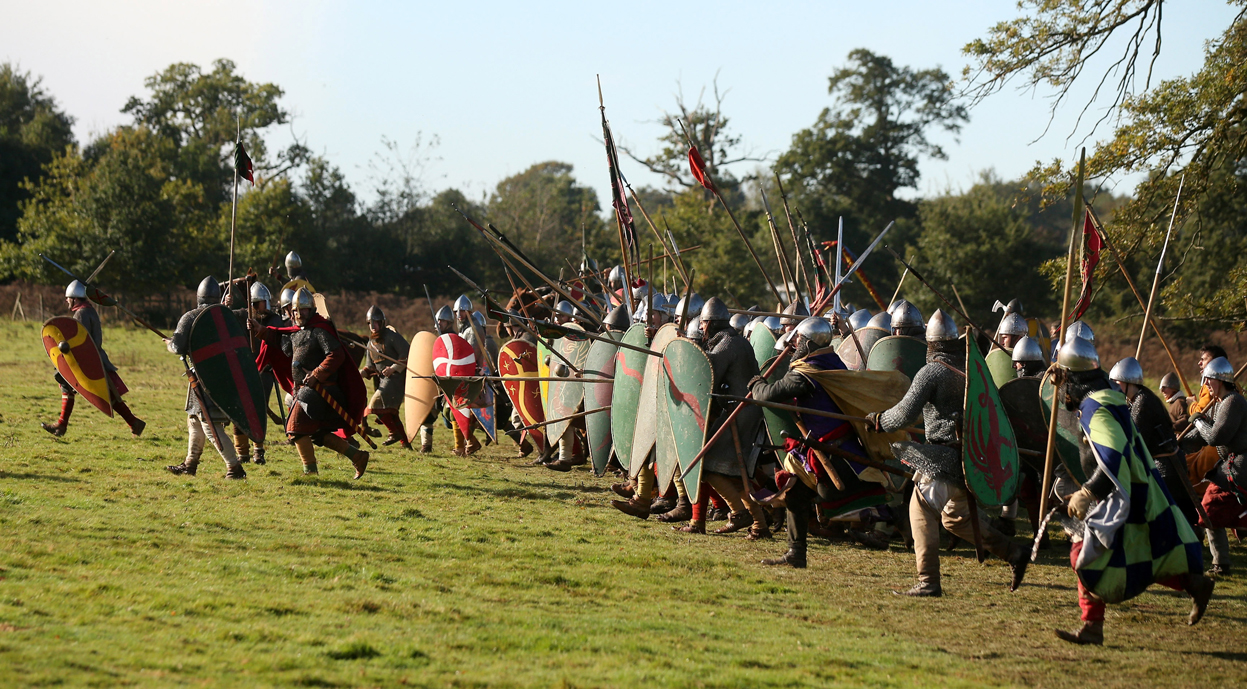By Babette Smits van Waesberghe
From across the hill an uproar can be heard. Metal on metal, shouting and yelling, the ground shaking. The sun can barely break through the clouds, but when it does it illuminates the scene in a golden glow; two armies fighting each other, men holding swords and shields, carrying banners and spears. Anyone stumbling across the scene would believe themselves to have stepped into a time machine and witness an actual battle in 11th century England. It is, however, the present day, and reenactments of historical topics take place all over the world. While some might say the reenactments are mere dress-up parties for adults, others find meaning in the historical educative merit of the reenactments. But how are leisure and historical education concerning reenactments balanced?
Historical Engagements
In his article ‘Empathy and Enfranchisement: Popular Histories‘ in The Journal of Theory and Practice [1], the historian Jerome de Groot considers three models of ‘experience’ for consumption and understanding of the past. All three uses of historical engagements ‘interact with the notion of ‘history’ as an academic pursuit but also create a space between ontological and intellectual approaches to the past’. The author discusses Reenactments and Empathy, Reality History and First Person Virtual History. Though the popularization of history by television and the enactment of historical experience in contemporary computer games are both fascinating models to study and write about, I have decided to focus solely on the model of Reenactments and Empathy for this article.
Dressing up like dead people
Haven’t most of us wanted to live in a certain era, experienced a deep nostalgia for a time long gone by? De Groot states that historical reenactments offer the participants the chance to ‘escape into the fact of the past, a space away from the present’. They offer men and women the opportunity to live during that certain era, to participate in a certain historical event, even if it’s only for a day. As De Groot puts it: ‘the re-enactor has a unique freedom to roam the centuries […] reenactment allows a unique exploration of life, unconstrained by the present’. D.A. Saguto, a reenactor himself, states in his article ‘Reflections on Reenactments’ in The Colonial Williamsburg Journal [2] that there is an element of escapism involved in ‘dressing up like dead people’ and playing make-believe. According to Saguto, some of the most serious reenactors take their avocation concerning their ‘hobby’ just as seriously as their work. He stresses though, that others are mostly out there for fun. They have no apparent interest in the educative aspect of reenactments. They are mainly interested in the ‘total immersion experience’: the feeling of actually having stepped back in time and being one of the inhabitants of times long passed. Saguto calls this ‘time-travel days’.
Educating the public
So, while there are reenactors who are mostly in it for fun and leisure, some reenactment groups claim to offer a performative, educational purpose. They stress that there is a great focus on historical accuracy and realism. The Sealed Knot, the oldest reenactment society in the UK, states that they operate with a view to educating the public and encouraging an interest in their heritage. Some reenactment groups even cater to requests of schools and in doing so, participate in educating school children. The Sealed Knot visits schools at their request in small groups ‘to give pupils a more hands-on approach to history by seeing us in costume, being able to ask us questions, and also handle some of the equipment we take with us. Pupils can learn about cookery, clothes, education and politics alongside the weapons and battle strategies in their own schools from people who have studied the period’.
Living History
One can wonder how much value there is in the educative aspect of the reenactments. While they do give a background story on the historical happenings and are almost unanimously historically accurate, I personally feel that they will mainly serve to spike the interest of the school children and hopefully enthuse them to interact with history on their own accord. I am not sure the educative aspect of the reenactment that, for example, the Sealed Knot likes to stress does indeed have such a big impact on school children. However, in my opinion it is never a bad thing to engage children with history from an early age. I myself loved visiting the Archeon in the Netherlands, which is basically a ‘museum of reenactment’. Whether I was born a lover of all things historical or not, the museum definitely brought the events of the past to life and gave me that same ‘total immersion experience’ Saguto describes. While the historical reenactments may not be the most thorough and academic approaches to history; they do serve to enliven it, to enthuse the public and maybe even educate. To me, that can only be a good thing.
[1] Jerome de Groot, “Empathy and Enfranchisement: Popular Histories” The Journal of Theory and Practice Vol. 10, No 3, 2006, pp. 391-413.
[2] D.A. Saguto, “Reflections on Reenactments” The Colonial Williamsburg Journal Winter 2011.
